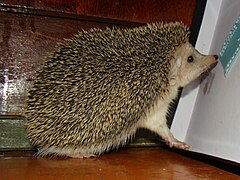Nephridiacanthus
| Nephridiacanthus | |
|---|---|
| Scientific classification | |
| Domain: | Eukaryota |
| Kingdom: | Animalia |
| Phylum: | Acanthocephala |
| Class: | Archiacanthocephala |
| Order: | Oligacanthorhynchida |
| Family: | Oligacanthorhynchidae |
| Genus: | Nephridiacanthus Meyer, 1931 |
| Synonyms | |
|
Nephridiorhynchus Meyer, 1931 | |
Nephridiacanthus is a genus of parasitic worms belonging to the family Oligacanthorhynchidae.[1]
The species of this genus are found in Africa.[1]
Taxonomy[edit]
Phylogenetic analysis has been conducted on one of the species in the genus, N. major.
| Archiacanthocephala |
| Phylogenetic reconstruction for select species in the class Archiacanthocephala based on a 28S rRNA gene comparison from Gomes et. al (2019) and a 18S rDNA gene comparison from Amin and colleagues (2020).[2][3] Amin and colleagues (2022) used the 18S rDNA gene and ITS1-5.8-ITS2 region of ribosomal RNA comparisons to add P. canicola phylogenetically to the family Oligacanthorhynchidae.[4] |
Description[edit]
Species[edit]
There are eight species in the genus Nephridiacanthus.[5][6][a]
- Nephridiacanthus gerberi Baer, 1959
- Nephridiacanthus kamerunensis Meyer, 1931
- Nephridiacanthus longissimus Golvan, 1962
- Nephridiacanthus major (Bremser, 1811)
N. major has been found infesting the long-eared hedgehog (Hemiechinus auritus) and the southern white-breasted hedgehog (Erinaceus concolor) in Iran, Germany, Morocco, central Asia, Egypt, Bulgaria, Tajikistan, Lebanon, Sicily, Italy, Nigeria, Turkey and Mongolia. Phylogenetic analysis has been done on the small subunit ribosomal DNA and cytochrome c genes, and have determined that it belongs to the family Oligacanthorhynchidae.[3]
- Nephridiacanthus manisensis Meyer, 1931
- Nephridiacanthus maroccanus Dollfus, 1951
- Nephridiacanthus palawanensis (Tubangui & Masiluñgan, 1938)
- Nephridiacanthus thapari (Sen & Chauhan, 1972)
Hosts[edit]

The life cycle of an acanthocephalan consists of three stages beginning when an infective acanthor (development of an egg) is released from the intestines of the definitive host and then ingested by an arthropod, the intermediate host. The intermediate hosts of Nephridiacanthus include ?. When the acanthor molts, the second stage called the acanthella begins. This stage involves penetrating the wall of the mesenteron or the intestine of the intermediate host and growing. The final stage is the infective cystacanth which is the larval or juvenile state of an Acanthocephalan, differing from the adult only in size and stage of sexual development. The cystacanths within the intermediate hosts are consumed by the definitive host, usually attaching to the walls of the intestines, and as adults they reproduce sexually in the intestines. The acanthor are passed in the feces of the definitive host and the cycle repeats. There are no known paratenic hosts (hosts where parasites infest but do not undergo larval development or sexual reproduction) for Nephridiacanthus.[9]
- Hosts for Nephridiacanthus
-
The Long-eared hedgehog is a host of N. major
Notes[edit]
- ^ A binomial authority in parentheses indicates that the species was originally described in a genus other than the present genus.
- ^ There are no known aberrant human infections for Nephridiacanthus species.[8]
References[edit]
- ^ a b "Nephridiacanthus Meyer, 1931". www.gbif.org. Retrieved 6 April 2021.
- ^ Gomes, Ana Paula N.; Amin, Omar M.; Olifiers, Natalie; Bianchi, Rita de Cassia; Souza, Joyce G. R.; Barbosa, Helene S.; Maldonado, Arnaldo (2019). "A New Species of Pachysentis Meyer, 1931 (Acanthocephala: Oligacanthorhynchidae) in the Brown-Nosed Coati Nasua nasua (Carnivora: Procyonidae) from Brazil, with Notes on the Genus and a Key to Species". Acta Parasitologica. 64 (3): 587–595. doi:10.2478/s11686-019-00080-6. PMC 6814649. PMID 31286360.
- ^ a b Amin, O.M.; Sharifdini, M.; Heckmann, R.A.; Zarean, M. (2020). "New perspectives on Nephridiacanthus major (Acanthocephala: Oligacanthorhynchidae) collected from hedgehogs in Iran". Journal of Helminthology. 94: e133. doi:10.1017/S0022149X20000073. PMID 32114988. S2CID 211725160.
- ^ Amin, Omar M.; Chaudhary, Anshu; Heckmann, Richard A.; Swenson, Julie; Singh, Hridaya S. (2022-03-01). "Redescription and Molecular Characterization of Pachysentis canicola Meyer, 1931 (Acanthocephala: Oligacanthorhynchidae) from the Maned Wolf, Chrysocyon brachyurus (Illiger, 1815) in Texas". Acta Parasitologica. 67 (1): 275–287. doi:10.1007/s11686-021-00458-5. PMID 34345996. S2CID 236914933. Archived from the original on 22 July 2023. Retrieved 28 December 2022.
- ^ Amin, Omar M. (September 19, 2013). "Classification of the Acanthocephala". Folia Parasitologica. 60 (4): 273–305. doi:10.14411/fp.2013.031. PMID 24261131.
- ^ "Nephridiacanthus Meyer, 1931". Integrated Taxonomic Information System (ITIS). November 3, 2023. Retrieved November 3, 2023.
- ^ CDC’s Division of Parasitic Diseases and Malaria (April 11, 2019). "Acanthocephaliasis". www.cdc.gov. Center for Disease Control. Archived from the original on 8 June 2023. Retrieved July 17, 2023.
- ^ Mathison, BA; et al. (2021). "Human Acanthocephaliasis: a Thorn in the Side of Parasite Diagnostics". J Clin Microbiol. 59 (11): e02691-20. doi:10.1128/JCM.02691-20. PMC 8525584. PMID 34076470.
- ^ Schmidt, G.D. (1985). "Development and life cycles". In Crompton, D.W.T.; Nickol, B.B. (eds.). Biology of the Acanthocephala (PDF). Cambridge: Cambridge Univ. Press. pp. 273–305. Archived (PDF) from the original on 22 July 2023. Retrieved 16 July 2023.

